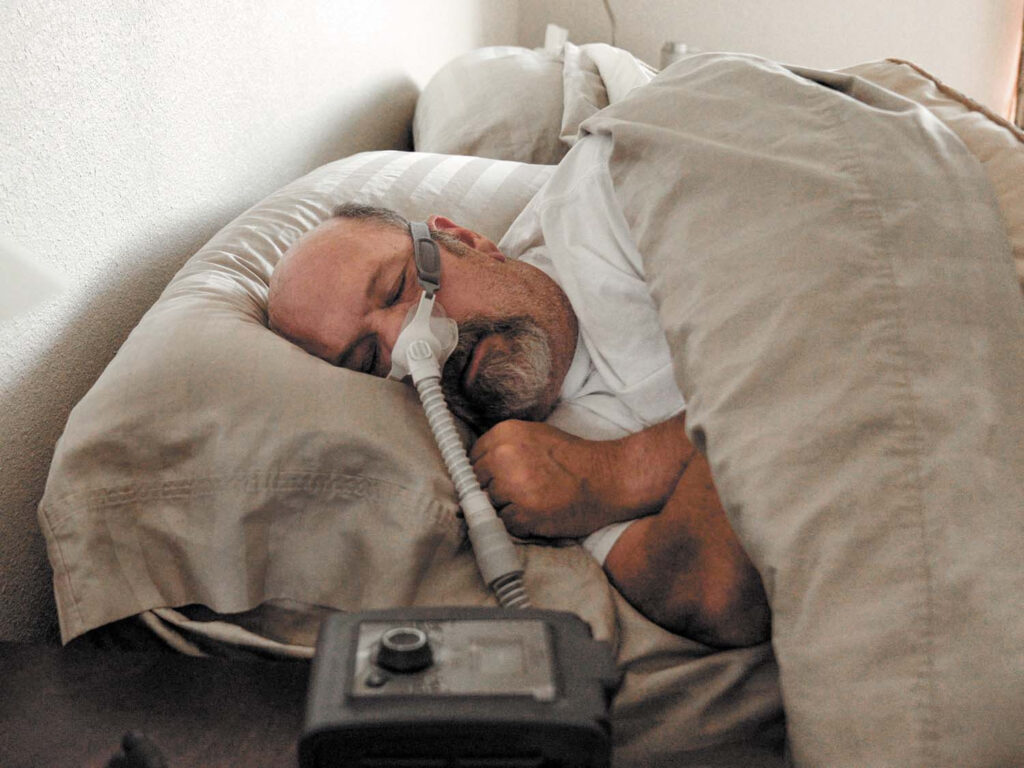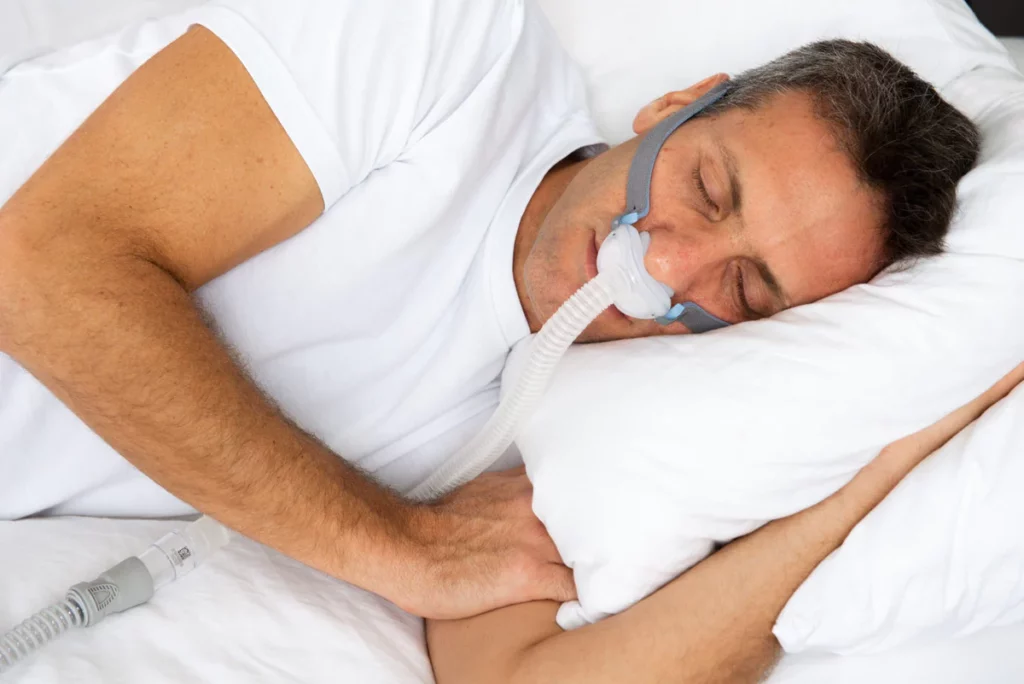Continuous Positive Airway Pressure (CPAP) therapy is the main treatment for sleep apnea, a condition that affects millions of people worldwide. This therapy delivers pressurised air through a specialised mask, keeping the airway open during sleep and preventing breathing interruptions.
The success of CPAP therapy depends largely on choosing the right mask. A well-chosen CPAP mask ensures:
- Optimal air pressure delivery
- Comfortable sleep throughout the night
- Minimal air leakage
- Proper seal maintenance
- Enhanced therapy compliance
The right mask must suit individual sleeping positions, breathing patterns, and facial features. A mask that works perfectly for one person might be uncomfortable or ineffective for another.
This guide explores various CPAP mask types, their specific features, and how to match them with different sleep styles. From nasal pillows to full-face options, understanding these variations helps create an effective sleep apnea treatment strategy tailored to individual needs.
Understanding CPAP Therapy and Its Components
CPAP machines are specialised medical devices that deliver a continuous stream of pressurised air to keep the airways open during sleep. The system works by pulling in room air through a filter, pressurising it to a specific level, and then sending it through a connected hose to the mask.

The main parts of a CPAP system are:
- Air Pump Unit: The main device that pressurises room air
- Air Filter: Removes dust and allergens from incoming air
- Humidification Chamber: Adds moisture to prevent nasal dryness
- Air Tubing: Connects the pump unit to the mask
- CPAP Mask: Delivers pressurised air to the user
The prescribed air pressure creates a pneumatic splint, keeping the airway open to prevent collapse during sleep. This mechanism effectively treats sleep apnea by maintaining consistent airflow throughout the night.
Importance of Mask-Machine Compatibility
Mask-machine compatibility plays a vital role in treatment success. Different CPAP machines, such as those available at Air Liquide Healthcare, generate varying pressure levels and airflow patterns. The chosen mask must:
- Handle the prescribed pressure without leakage
- Connect securely to the machine’s tubing
- Maintain proper seal during pressure changes
- Support any special features like pressure relief or ramp settings
A properly matched mask-machine combination ensures optimal pressure delivery and minimises air leaks, creating the foundation for successful sleep apnea treatment.
Additional Benefits for Respiratory Issues
In addition to CPAP therapy, individuals with respiratory issues may also benefit from portable oxygen concentrators or home oxygen machines which are also available at Air Liquide Healthcare. These devices can significantly improve breathing and overall quality of life for those with chronic respiratory conditions.
Learn more on: What to Look for in a CPAP Machine: A Buyer’s Guide for First-Time Users
Exploring Different Types of CPAP Masks
CPAP masks come in several distinct designs, each engineered to meet specific breathing patterns and comfort requirements. Understanding the characteristics of each type helps patients make informed decisions about their therapy equipment. Learn more about comfort on https://pubmed.ncbi.nlm.nih.gov/16173678/

Nasal Masks
Nasal masks create a triangular seal around the nose, extending from the bridge to the upper lip. These masks offer:
- Natural airflow delivery through the nasal passages
- Reliable performance at higher pressure settings
- Multiple size options for different facial structures
The bulkier design can present challenges for active sleepers and may cause bridge-of-nose discomfort during extended use.
Nasal Pillow Masks
These lightweight masks feature small silicone cushions that insert directly into the nostrils:
- Minimal facial contact reduces claustrophobic feelings
- Clear field of vision for reading or watching television
- Excellent option for patients with facial hair
Pressure limitations exist with nasal pillow masks, making them less suitable for patients requiring higher CPAP settings.
Full-Face (Oronasal) Masks
Full-face masks cover both the nose and mouth, creating a seal around these areas:
- Essential for mouth breathers
- Beneficial during seasonal allergies or nasal congestion
- Effective at high-pressure settings
The larger surface area can feel restrictive and may interfere with side sleeping positions.
Oral/Hybrid Masks
These specialised masks accommodate various breathing patterns:
- Direct oral ventilation for exclusive mouth breathers
- Combination designs for mixed breathing patterns
- Reduced bulk compared to full-face options
Oral masks require precise fitting to prevent air leakage and may need additional chin support to maintain seal integrity during sleep.
Each mask type requires proper sizing and adjustment to achieve optimal therapeutic benefits. The mask’s seal integrity, comfort level, and compatibility with prescribed pressure settings play crucial roles in treatment success. For a wide selection of CPAP masks including full face, nasal pillow & nasal masks, you can shop online at Air Liquide Healthcare.
Considering Your Sleep Style in Mask Selection
Sleep position plays a crucial role in determining the most suitable CPAP mask for optimal therapy. Different sleeping positions create varying pressure points and mask stability requirements, making certain mask designs more appropriate for specific sleep styles. Click here to find more about pressure.
Side Sleepers
- Nasal pillow masks provide the best solution due to their minimal contact design
- The compact structure prevents mask displacement when the face presses against the pillow
- Reduced bulk eliminates pressure points on facial areas that contact the pillow
- Minimal interference with peripheral vision adds comfort for reading before sleep
Back Sleepers
- Multiple mask options work well in this position
- Traditional nasal masks offer excellent stability with reinforced headgear
- Full-face masks maintain reliable seals without gravity-induced leaks
- Adjustable forehead support systems help prevent mask rotation
Stomach Sleepers
- Ultra-lightweight nasal pillow masks prove essential
- Short tubing configurations reduce pull on the mask
- Minimal contact points allow natural head positioning
- Flexible cushioning materials adapt to pressure changes from pillow contact
Sleep position changes throughout the night affect mask performance. Selecting a mask that accommodates primary sleeping positions helps maintain consistent therapy. The mask should allow natural movement while maintaining proper sealing and comfort levels.
Facial structure variations in different positions require consideration:
- Relaxed jaw positions in back sleeping
- Compressed facial tissue in side positions
- Extended neck angles in stomach sleeping
These positional changes influence the effectiveness of different mask designs and their ability to maintain proper sealing throughout the night.
Matching Mask Type to Breathing Patterns and Facial Features
Individual breathing patterns and facial characteristics play a crucial role in determining the most effective CPAP mask selection. Understanding these personal factors helps ensure optimal therapy outcomes and comfort during sleep.
Breathing Pattern Considerations
Mouth Breathers
- Full-face masks cover both nose and mouth, preventing air leakage
- Suitable for patients with chronic nasal congestion
- Ideal for those who experience dry mouth symptoms
- Beneficial during allergy seasons or respiratory infections
Nose Breathers
- Nasal masks provide targeted air delivery
- Less bulky design enhances comfort
- Better suited for patients requiring higher pressure settings
- Reduced risk of air leakage with proper fit
Facial Features Impact
Facial Hair Considerations
- Dense facial hair can create gaps between mask and skin
- Full-face masks may require frequent adjustment with beards
- Nasal pillow masks often work better with moustaches
- Regular maintenance needed to maintain seal integrity
Facial Structure Variations
- High bridge nose: Consider masks with flexible cushioning
- Wide face: Full-face masks with adjustable straps
- Narrow face: Compact nasal masks or nasal pillows
- Deep creases: Masks with gel-based cushioning
Special Considerations
- Claustrophobia: Minimal-contact masks recommended
- Glasses wearers: Low-profile designs reduce interference
- Active sleepers: Secure headgear systems prevent displacement
- Sensitive skin: Hypoallergenic materials reduce irritation
Ensuring Proper Fit, Comfort, and Seeking Professional Guidance in Your Mask Choice Journey
A properly fitted CPAP mask is the key to successful sleep apnea therapy. The mask should create a secure seal without causing discomfort or pressure points during extended wear.
Common Issues from Improper Fit:
- Air leaks around mask edges
- Skin irritation and pressure marks
- Mask displacement during sleep
- Dry nose, mouth, or throat
- Noisy operation due to escaping air
Essential Fitting Guidelines:
- The mask should sit snugly without excessive pressure
- Straps require adjustment while lying in sleeping position
- Minimal movement when turning head
- No significant air leaks when pressure is applied
Many CPAP users benefit from comfort accessories to enhance their experience:
- Mask liners to prevent skin irritation
- Strap cushions for added comfort
- Chin supports to prevent mouth breathing
- Moisture-wicking headgear
The initial mask selection process should include trying different sizes and styles under professional supervision. Sleep specialists recommend testing each mask for:
- Comfort in various sleeping positions
- Seal effectiveness at prescribed pressure settings
- Compatibility with facial features
- Ease of adjustment and cleaning
A mask fitting session allows users to experience different options while receiving expert guidance on proper positioning and adjustment techniques. Professional mask fitters can identify potential issues and suggest appropriate solutions before they impact therapy effectiveness.
Consulting Healthcare Providers for Personalized Mask Selection & Final Tips
Sleep specialists and respiratory therapists play a vital role in the CPAP mask selection process. These healthcare professionals possess extensive knowledge of sleep disorders and breathing patterns, enabling them to:
- Conduct thorough assessments of facial features and anatomy
- Analyse individual breathing patterns during sleep
- Evaluate specific treatment requirements and pressure settings
- Recommend appropriate mask types based on clinical expertise
A professional consultation allows patients to benefit from personalised guidance, ensuring the selected mask aligns with their unique needs. Sleep specialists can identify potential challenges and suggest preventive measures, reducing the likelihood of treatment complications.
In addition to CPAP masks, healthcare providers might also recommend other devices such as the Aerobika with Manometer for better management of respiratory conditions. This device not only aids in your therapy but also tracks your pressure in real-time, providing valuable data for your healthcare provider.
Key Considerations for Long-Term Success:
- Schedule regular follow-up appointments to address fit issues
- Document sleep patterns and mask-related concerns
- Request mask adjustments when comfort or effectiveness diminishes
- Consider seasonal changes that might affect mask performance
The path to successful CPAP therapy requires dedication to finding the right mask. Patients who prioritise proper fit and comfort, combined with professional guidance, experience better treatment outcomes. Regular consultations with healthcare providers ensure the selected mask continues to meet therapeutic needs while maintaining optimal comfort levels for consistent, long-term use.
Professional tip: Keep a sleep diary during the first few weeks of using a new CPAP mask to track comfort levels and any issues that arise. This information helps healthcare providers make necessary adjustments to enhance treatment effectiveness.
For patients requiring supplemental oxygen, options like the Philips Everflo Oxygen Concentrator may be suggested by healthcare providers. This device is known for its quiet operation and energy efficiency, making it ideal for home oxygen needs.

